Need a Substitute for Sriracha? Here Are 14 Great Alternatives
Updated: Jun. 27, 2023

It's hard to think of life without our beloved rooster sauce, but if you can't find your favorite condiment at the store, here are the best hot sauces and substitutes for Sriracha.
Sriracha isn’t just another bright red hot sauce, it’s an obsession. Devoted fans (like us) put it on everything, from scrambled eggs to pho, burritos, burgers, grilled cheese, pizza and so many other things (here are some of our favorite Sriracha recipes).
California-based Huy Fong Foods’ “rooster sauce,” known as such because of the logo, is the most ubiquitous Sriracha chili sauce brand. Producing about 20 million bottles a year, it’s reached iconic status that goes way beyond a condiment—it’s inspired cookbooks, clothing and numerous knock-offs.
So when you hear about a(nother) Sriracha shortage, it’s big news. If it’s not supply chain issues, it’s climate change affecting garlic and chile pepper harvests. And without those, that potentially means a lot fewer bottles of sriracha out there, and life is just too short to go without a dash of extra spice.
What’s the Best Sriracha Substitute?
Based on a popular Thai condiment, Sriracha (pronounced see-ROTCH-ah) is most commonly made with red jalapeno peppers, garlic, distilled white vinegar, sugar and salt. The original version is thicker than a liquid hot sauce, more like a paste. But most Sriracha you find on grocery store shelves today is thin enough to squeeze through a nozzle.
Any hot sauce worth its Scoville rating is made with similar ingredients as Sriracha, but each has its own distinctive flavor depending on the chiles used, the spices, and how much water or sugar is in it. Some are more mild, some spicier; some even have a little sweetness. If you didn’t stock up for the impending Srirachapocalypse, there are plenty of other spicy Sriracha substitutes out there.
Tapatio
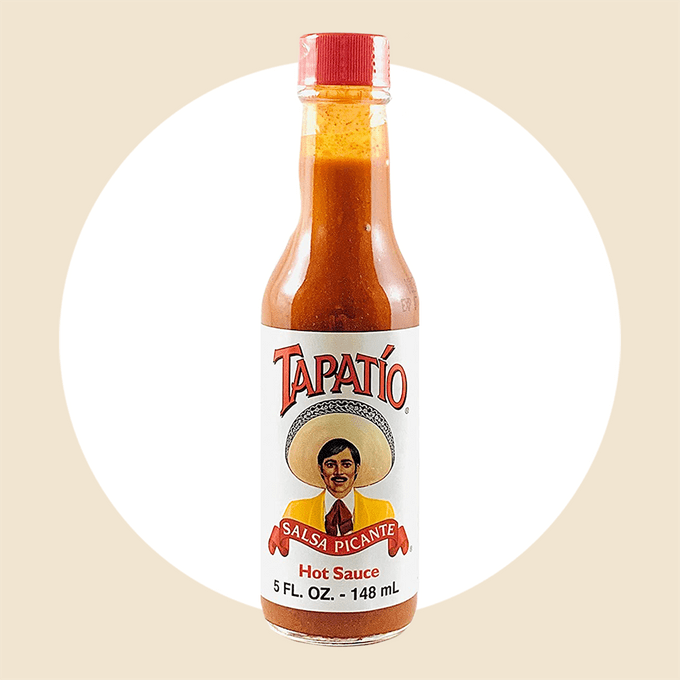
Based on Mexican salsa picante but made in California, Tapatio has a little more heat than Sriracha, but it won’t burn your face off. Made with red chile peppers (though we don’t know exactly which ones), vinegar, garlic, salt and spices, it’s on the thinner side of the hot sauce spectrum but has a great flavor.
Like Sriracha, it’s a good hot sauce to shake on eggs, tacos, rice dishes and anything else that needs a nice kick of heat. You can find Tapatio on grocery store shelves just about everywhere.
Cholula
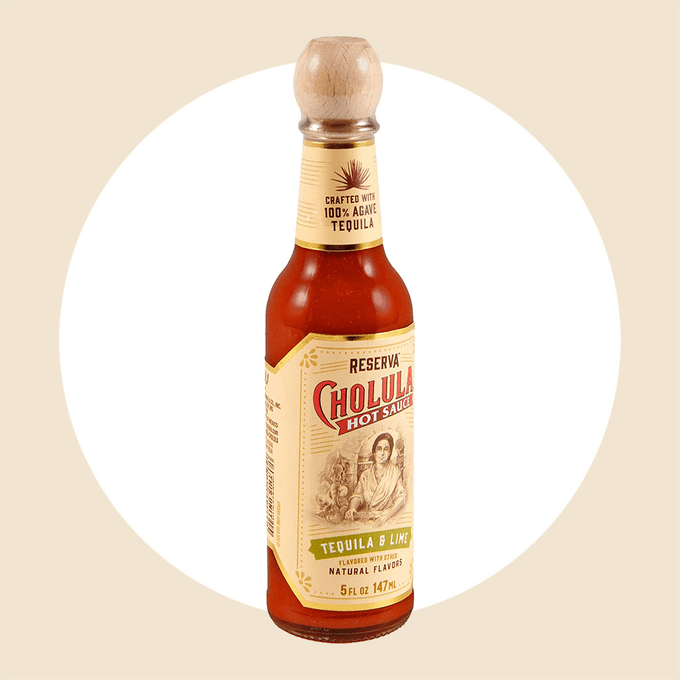
Many Mexican-style hot sauces have a thinner consistency than Sriracha, and they have varying amounts of vinegar if any at all. Cholula is a bit more complex than most, however. Thanks to its use of arbol chiles and pequin peppers, plus vinegar, garlic powder, salt and spices, it’s a delicious smoky, tangy and slightly spicy hot sauce. It’s not face-meltingly hot, but there’s a nice amount of heat to go around.
Add Cholula to soups and stews, add a splash or two to tacos or taco dip, stir into Spanish rice or drizzle over eggs, potatoes or roasted vegetables. Basically, anywhere you’d use Sriracha, you can use Cholula. It’s widely available in grocery stores across the country.
Tabasco

Everyone has a bottle of Tabasco hot sauce somewhere. A kitchen staple for generations, born and still produced in Louisiana, Tabasco’s original formula is simply made from tabasco peppers, vinegar and salt. The thin, slightly salty sauce is super versatile and can be used either as a condiment or a cooking ingredient. It’s slightly hotter than Sriracha, but you can still use it as a good substitute.
Use Tabasco in marinades, mixed into dips or noodle bowls, and add to sauces, like for these slow-cooker pulled pork sandwiches. Sprinkle it over eggs, pizza, tacos, burgers and more. Louisiana-style hot sauce is what you typically use in Buffalo chicken recipes, and it’s most important for a proper Bloody Mary (after vodka of course).
Chili Crisp
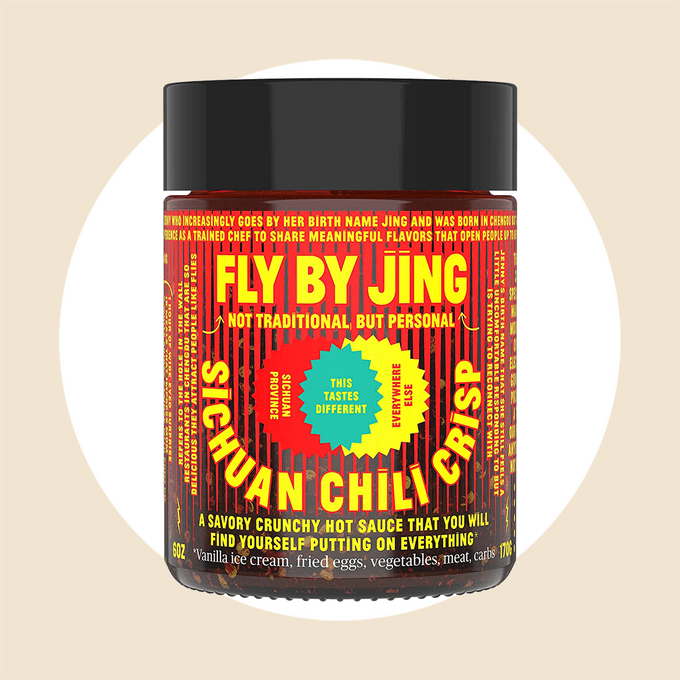
Spicy chili crisp is up there with Sriracha as far as trendy condiments go, with many versions on the marketplace today. A blend of various peppers, dried garlic, onion, spices and sometimes peanuts, it has an umami savoriness and just enough heat to keep things interesting. It’s not really a sauce or a paste, just all crispy texture, spice and everything nice.
Use chili crisp on anything: Eggs, avocado toast, baked potatoes, tacos, pasta dishes, steaks, fish, any pizza recipe and more. It’s even good on vanilla ice cream! You can find chili crisp just about anywhere now. LoaGanMa was the original out of China, but now there’s Fly by Jing’s Sichuan Chili Crisp, Mr. Bing Chili Crisp, celebrity chef chili crisps, and of course Trader Joe’s own brand.
Chili Oil

Chili oil and chili crisp aren’t exactly the same thing, but they do come from the same family of condiments. Usually made with vegetable or sesame oil simmered with red chile pepper flakes, ground Sichuan peppercorns, garlic, star anise and paprika, it’s more of an oil flavored with chile peppers. Chili crisp, by contrast, has dried ingredients and crunchy goodness sort of suspended in oil; you scoop it all up.
You’ll see this dark red oil on the table at Chinese restaurants, especially those specializing in Sichuan cuisine. We love to drizzle it on soup dumplings, pork and chive pot stickers, noodles of any kind, in any stir fry or on scallion pancakes. It’s not a one-to-one Sriracha substitute, but it packs some spicy heat.
Sambal Oelek
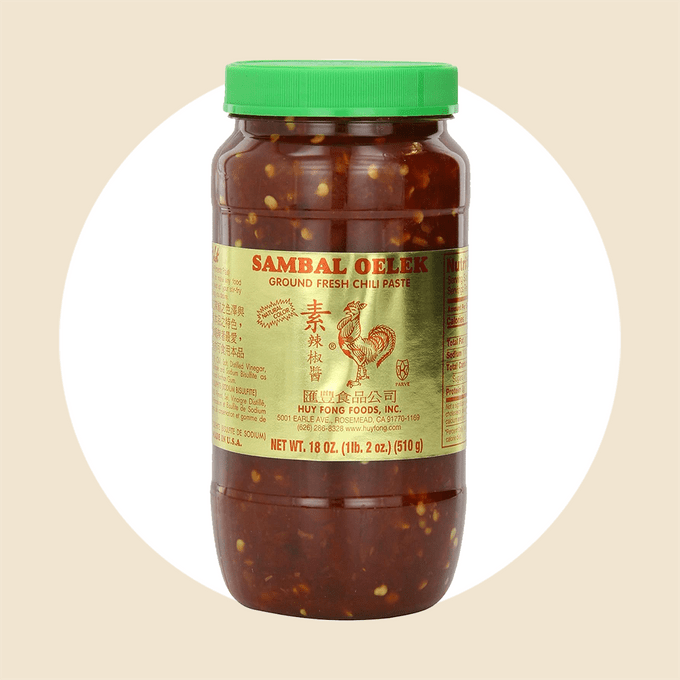
This traditional Indonesian chili sauce is a lot like Sriracha but in paste form. While the base of both is similar—red chile peppers, vinegar and salt—sambal oelek is chunkier than Sriracha and not as smooth; you’ll still see the pepper seeds, for instance. It’s also a bit spicier than Sriracha since there are less ingredients (no sugar or garlic).
Huy Fong Foods, the same producers of “rooster” Sriracha, also makes sambal oelek (it has the famous rooster on the label, too), but with the chile pepper shortage that’s affecting Sriracha, Huy Fong Foods sambal oelek might also be harder to find on store shelves. There are other brands out there, and with only three ingredients, it’s pretty easy to make at home. It’s best used to season dishes, like stews, soups and noodles.
Peri-peri Sauce

If you like things spicier than sriracha, peri-peri sauce is a good way to add some heat. Made with African peri-peri peppers (also known as piri-piri and African bird’s eye chile pepper), which rank much higher on the Scoville scale than red jalapeno peppers, it packs a spicy punch. Other ingredients can include lemon, garlic, salt, onion, vinegar and other herbs and spices.
As a condiment, peri-peri sauce is a good Sriracha substitute, but it’s definitely hotter. You can use it in marinades, or as a marinade on its own, like in this sweet and hot chicken dish. Trader Joe’s makes a peri-peri sauce, which they tout is good for everything from hummus to tater tot nachos. Nando’s is a popular brand that’s pretty widely available, too.
Gochujang

Gochujang is a staple in Korean cooking. The thick, sticky paste is sweet, spicy and a little funky (in the best way) with a concentrated flavor. Unlike Sriracha, it sometimes needs a bit thinned out, which is why it’s good for marinades and sauces. Made with red chili powder, sticky rice, fermented soybean powder, malt barley powder and salt, it’s not as spicy as Sriracha, making it ideal for dishes that call for a sweeter umami-packed bump.
One popular Korean brand, O’Food Gochujang Korean Red Chili Pepper Paste, can be ordered if you can’t find it at a local grocery store. Brooklyn-based Bushwick Kitchen makes Weak Knees Gochujang Sriracha, that’s pretty tasty. Use either as a meat marinade, especially in traditional Korean bibimbap, in noodle bowls, or stirred into soups and stews. Gochujang is a great addition to something like these gingered short ribs and a good Sriracha substitute in this slow-cooker Korean beef recipe. You can use it in this vegetarian stir-fry rice bowl or this Korean sausage bowl, too.
Sweet Chili Sauce
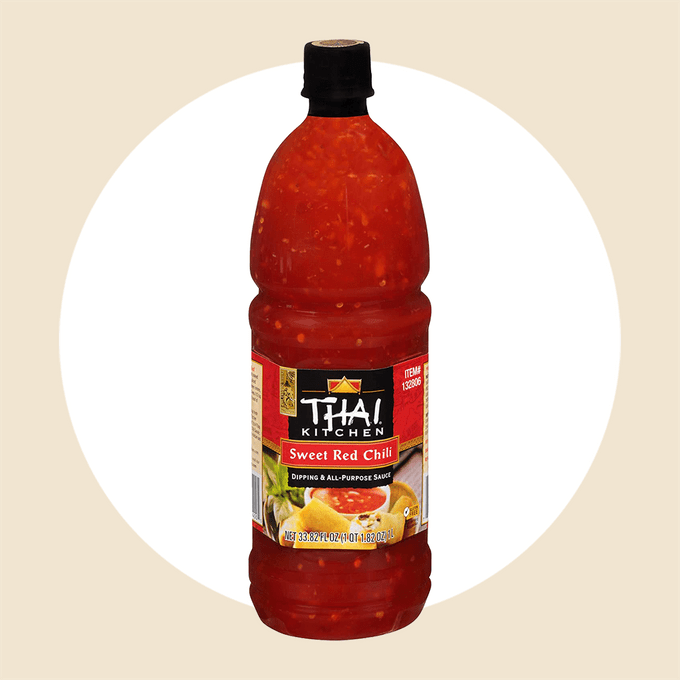
Made from basically made of the same ingredients as sriracha—red chiles, garlic, salt and vinegar—sweet chili sauce has a different flavor profile thanks to sugar and other ingredients. Sweet chili sauce doesn’t have as much hot pepper, however, so it’s not as spicy but still has a little zip.
On its own, the thicker but still pourable sauce is perfect for dipping spring or egg rolls, pan-fried pot stickers, fried shrimp or chicken. It makes a dynamite barbecue sauce for ribs, and is an absolute must for Thai sweet chili pork bowls and sweet chili orange chicken. There are many brands on grocery store shelves, each tasting a little different depending on the recipe; some may have more chiles, some more sugar, some might be a little funky. We like Mae Ploy Sweet Chili Sauce for its chunky texture and Trader Joe’s version for its balance. Thai Kitchen’s Sweet Red Chili Sauce is always a good bet, too.
Harissa
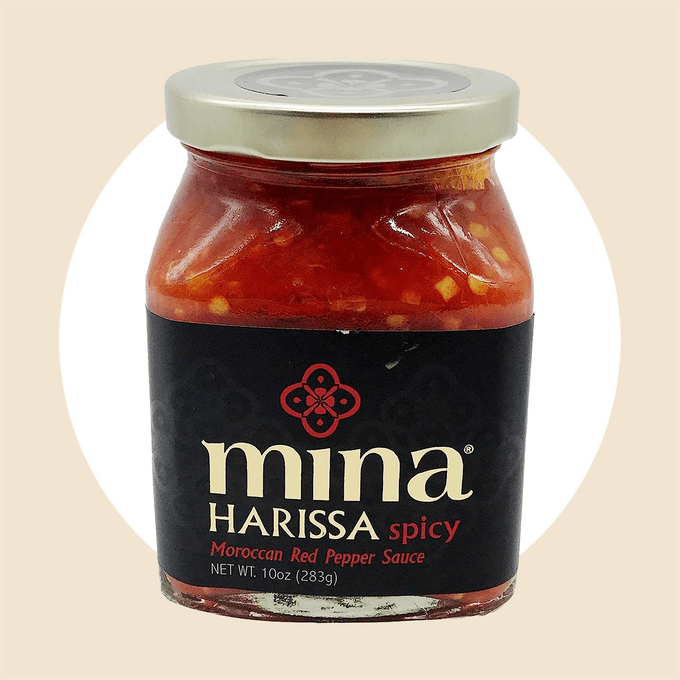
You’ve probably seen more recipes calling for harissa as the spicy, thick paste has gained popularity around the country. An integral part of North African cooking, it’s a combination of dried chiles like bird’s eye and serrano, oil, and herbs and spices like coriander, cumin, caraway and garlic. It has varying degrees of heat depending on the recipe, and some can be quite hot.
Compared to Sriracha, harissa is more herbal and savory, and can really add some oomph to just about anything. Mix it into plain hummus for a unique kick, or with ketchup for a spicy dip for fries or for your burgers. Add a spoonful or two to these Moroccan chicken tagine pockets or West African chicken stew or as a sauce for braised beef. You’ll most likely see it in a jar on grocery store shelves and gourmet markets. Mina Harissa is quite delicious, as is Trader Joe’s. Mustapha’s Mediterranean Harissa is balanced and complex, made with chiles, red pepper and preserved lemon.
Fly by Jing Zhong Sauce

Inspired by a classic Chengdu street snack, this sauce simmers an aromatic soy sauce with brown sugar, toasted sesame oil, dried chiles, mushrooms, garlic and spices. It’s spicy but not too hot from the piquant chiles, kind of tangy-sweet, full of umami, and intense enough that you don’t want to use too much but super versatile.
This savory and sweet sauce is more akin to chili crisp or oil than Sriracha, but it’s a great Sriracha substitute when using it on anything from pot stickers to scrambled eggs, breakfast burritos, burgers and sandwiches. Look for Fly by Jing’s Zhong Sauce wherever you find the Fly by Jing Chili Crisp, in your local grocery store or online.
Homemade Hot Sauce

At first you might think making your own hot sauce isn’t worth the effort, especially since there are so many varieties widely available at the store. But we’re here to tell you it’s definitely easier than you think.
There are many ways to make hot sauce—the choice of chile peppers seems endless, plus herbs and spices, whether you use fermentation or simply simmer your sauce on the stove. Our recipe for homemade spicy hot sauce uses garden-fresh ingredients (even carrots!) for a delicious hot sauce you’ll want to put on everything.
Ketchup and Hot Sauce

While making Sriracha on your own isn’t difficult, in a pinch you can simply blend your favorite ketchup with Frank’s RedHot or other Louisiana-style hot sauce. Together they make something that closely resembles the sweet, vinegary taste of Sriracha.
Ketchup adds the right texture with a bit of umami and sweetness, and the hot sauce, while too thin and spicy to be a one-to-one Sriracha substitute on its own, brings the acid and heat. Start with a ratio of about three to one (ketchup to hot sauce), and spice it up from there.
Other Sriracha Brands
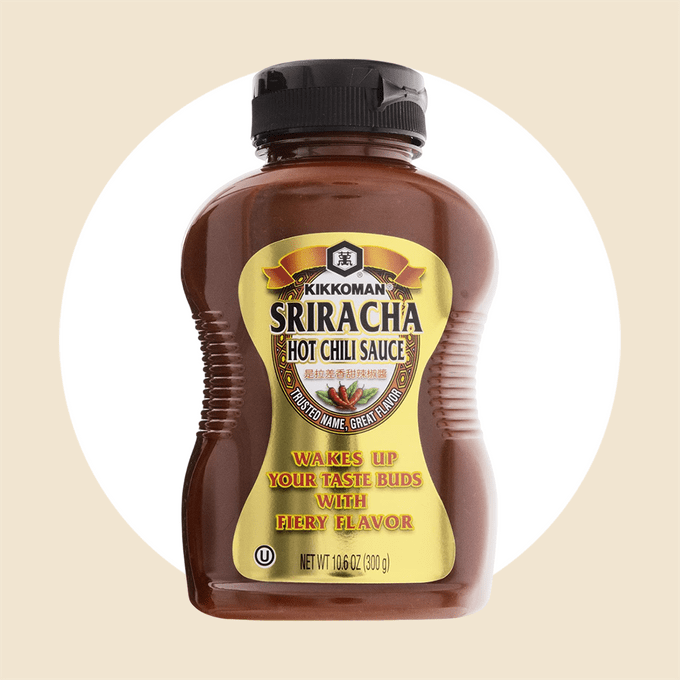
Of course, Huy Fong Foods isn’t the only Sriracha out there! Trader Joe’s sriracha is a good alternative for the “rooster” sauce, and well-known brands like Kikkoman have their own version. Brooklyn-based Bushwick Kitchen makes Weak Knees Curry Sriracha (the same company who makes the gochujang blend mentioned above), and even Frank’s RedHot makes a Sriracha. If you go to any Asian grocery store, you’ll see different Sriracha brands on the shelf, as well. Give any a go! You may find your new favorite.
